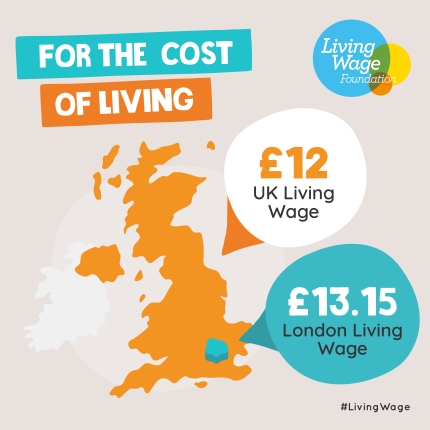Don’t Be A Minimum Wage Cheat – New Rates Are In Force Now
Around 2.5 million UK workers should have received a pay rise, as the National Minimum Wage and National Living Wage increase came into effect on 1 April...
Read Full Article
Over 460,000 Living Wage workers are set for a pay boost as 14,000 Living Wage employers are signed up to pay new rates – a 10% increase in the Real Living Wage as the cost of living continues to hit low paid workers the hardest.
The new Real Living Wage rates are now worth over £3,000 more per year in the UK than the minimum wage and over £5,000 more in London – the Conservative government refers to the minimum wage as the ‘national living wage’. The Living Wage Foundation, which originally coined the phrase ‘Living Wage’, has, since 2011, campaigned for pay to reflect the real-life circumstance of those just getting by on what they earn. It remains the only wage rate independently calculated based on what people need to live on. This year the rate increased by 10% in the UK, reflecting persistently high costs for low paid workers.
Over 460,000 people working for 14,000 Real Living Wage employers throughout the country will see rates rise to £12 an hour across the UK (£1.10 increase) and £13.15 an hour in London (£1.20 increase).
Cost-of-living crisis
Recent research by the Living Wage Foundation shows that despite inflation easing, the cost-of-living crisis is far from over for Britain’s 3.5m low paid workers. Recent polling of those earning below the Real Living Wage found that 60% have visited a food bank in the past year with 39% regularly skipping meals for financial reasons.
The Real Living Wage vs the National Living Wage – the difference
A full-time worker earning the new Real Living Wage would earn £3,081 a year more than a worker earning the current government minimum (NLW) and £2,145 more than their current pay. In London, a full-time worker on the new real Living Wage rate would earn an additional £5,323.50 a year compared to a worker on the current NLW.
Low pay
There are 3.5m jobs (12.2% of employee jobs, or 1-in-8 jobs) paid less than the Real Living Wage. According to Living Wage Foundation projections, the scale of low pay is predicted to increase to 4.3m (15.7% of jobs) in 2023.
The Living Wage movement continues to grow
In the past two years, record numbers of employers have signed up to pay the Real Living Wage, including to their third-party contractors, with 1-in-9 employees now working for an accredited Living Wage Employer.
There are now 14,000 Living Wage employers, including half of the FTSE 100, as well as thousands of small businesses, which are choosing to pay the Real Living Wage to provide workers and families with greater security and stability.
Living Hours
There are now also over 100 Living Hours employers going beyond payment of the Real Living Wage to also provide a guaranteed minimum of 16 hours work a week, a month’s notice of shift patterns and a contract that reflects hours worked.
“As inflation eases, we cannot forget that low paid workers remain at the sharp end of the cost-of-living crisis. Low paid workers continue to struggle with stubbornly high prices because they spend a larger share of their budget on food and energy.”
– Katherine Chapman
Director, Living Wage Foundation
Business sense
Brett Mendell, a director at Thomas Kneale, a Living Wage employer and textiles company based in Manchester, says "People are our biggest asset. Paying the Real Living Wage and above has significant benefit to both our colleagues and to the company. Our team report lower stress and reduced financial anxiety, a higher standard of living and a lift in morale. We have also seen productivity improvements while delivering a labour turnover reduction of 60% and a staff absence decrease of 75% since we became accredited in 2015. We're also a Living Hours accredited employer, so our team also has security of hours along with other benefits."
Living Pensions
Living Pensions is a voluntary savings target for employers that was developed to tackle poverty in retirement. There are now 21 Living Pension employers committed to help workers build up a pension pot that will provide enough income to meet basic everyday needs in retirement.
Picture: The Real Living Wage rate has gone up as of Tuesday 31 0ctober 2023.
Article written by Cathryn Ellis
24th October 2023